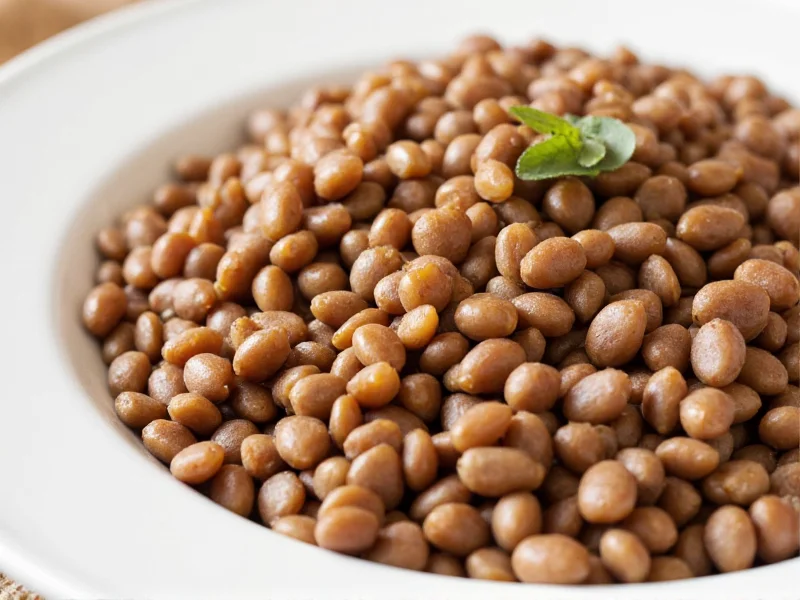Brown lentils (Lens culinaris) represent one of the most versatile and widely available lentil varieties globally. These lens-shaped pulses feature a mottled brown exterior with pale interiors and deliver exceptional nutritional value alongside culinary flexibility. When properly prepared, they offer a hearty, earthy flavor profile that complements both vegetarian and meat-based dishes.
What Exactly Are Brown Lentils?
Botanically classified as Lens culinaris, brown lentils belong to the legume family and rank among the oldest cultivated crops worldwide. Their distinctive flattened lens shape gives them their name. Common varieties include Spanish Brown, Eston, and Masoor Dal (though Masoor often refers to red lentils in some regions).
Unlike their split counterparts, whole brown lentils retain their seed coat, contributing to their longer cooking time and ability to maintain structural integrity. This characteristic makes them particularly valuable for recipes requiring distinct texture, such as cold salads or chunky stews where disintegration would compromise the dish's consistency.
Nutritional Powerhouse: Health Benefits of Brown Lentils
One cooked cup (198g) of brown lentils delivers remarkable nutritional density:
- Protein: 18g (36% of daily value)
- Fiber: 15.6g (56% of daily value)
- Folate: 358mcg (90% of daily value)
- Iron: 6.6mg (37% of daily value)
- Manganese: 1.3mg (57% of daily value)
Regular consumption supports cardiovascular health through soluble fiber that helps manage cholesterol levels. The complex carbohydrates provide sustained energy release, making brown lentils an excellent choice for blood sugar management. Their high folate content proves particularly beneficial during pregnancy for neural tube development.
Cooking Brown Lentils: Essential Techniques
Mastering brown lentil preparation ensures optimal texture and flavor. Unlike many legumes, they require no presoaking, though sorting and rinsing remains essential to remove debris.
For perfect results, use a 2.5:1 water-to-lentil ratio. Bring to a boil, then simmer uncovered for 20-30 minutes until tender but still holding shape. Avoid adding salt or acidic ingredients like tomatoes until the end of cooking, as these can significantly increase cooking time and affect texture.
When properly cooked, brown lentils should be tender with a slight bite, maintaining their distinct shape without becoming mushy. Overcooking transforms them into an unappealing paste, while undercooking leaves them unpleasantly crunchy.
Brown Lentils Compared to Other Varieties
Understanding lentil differences helps select the right variety for specific recipes. This comparison highlights key distinctions:
| Lentil Type | Color/Appearance | Cooking Time | Texture When Cooked | Best Uses |
|---|---|---|---|---|
| Brown Lentils | Mottled brown | 20-30 minutes | Firm, holds shape | Soups, stews, salads |
| Green Lentils | Olive green | 25-30 minutes | Firmest texture | Salads, side dishes |
| French Lentils | Dark green/black | 25-30 minutes | Very firm | Gourmet salads, pilafs |
| Red/Yellow Lentils | Orange/yellow when split | 10-15 minutes | Soft, creamy | Dals, purees, thick soups |
| Black Lentils | Jet black | 25-30 minutes | Firm with earthy flavor | Salads, grain bowls |
Delicious Ways to Use Brown Lentils
Brown lentils shine in numerous culinary applications thanks to their ability to maintain structure while absorbing flavors. Consider these preparation methods:
Lentil Soup Foundation: Their sturdy texture makes brown lentils ideal for hearty soups. Combine with vegetables, broth, and herbs for a satisfying meal. The classic French Lentil Soup (Soupe aux Lentilles) demonstrates their versatility in traditional cuisine.
Salad Staple: Cooked and cooled brown lentils provide protein-rich substance to salads. Toss with vinaigrette, roasted vegetables, and goat cheese for a complete meal salad that holds well for meal prep.
Vegan Meat Substitute: When combined with mushrooms, oats, and seasonings, brown lentils create convincing vegan burgers or meatloaf alternatives that maintain integrity during cooking.
Storage Guidelines for Maximum Freshness
Proper storage preserves brown lentils' quality and extends shelf life. Store dried lentils in airtight containers in a cool, dark pantry location for up to 12 months. Exposure to light, heat, or moisture accelerates nutrient degradation and may encourage pest infestation.
Cooked brown lentils maintain quality for 5-7 days when refrigerated in sealed containers. For longer storage, freeze portions in freezer-safe bags for up to 6 months. Thaw frozen lentils overnight in the refrigerator before use.
Common Questions About Brown Lentils
Do brown lentils need to be soaked before cooking?
No, brown lentils don't require soaking before cooking. Unlike larger beans, their small size allows them to cook relatively quickly (20-30 minutes) without presoaking. Simply rinse them thoroughly to remove any debris before cooking.
How can I prevent my brown lentils from becoming mushy?
To maintain firm texture, avoid adding salt or acidic ingredients like tomatoes or vinegar until the lentils are nearly cooked. These substances can toughen the lentils' exterior, requiring longer cooking that often leads to mushiness. Check lentils frequently during the final cooking minutes.
Are brown lentils healthy for weight management?
Yes, brown lentils support weight management through their high fiber and protein content, which promotes satiety. With approximately 230 calories per cooked cup and minimal fat, they provide substantial nutrition while helping control hunger between meals.
Can I substitute brown lentils for green lentils in recipes?
Generally yes, though green lentils maintain slightly firmer texture. Brown lentils work well as substitutes in soups and stews, but for salads where distinct texture matters, French or green lentils might perform better. Red lentils aren't suitable substitutes when texture retention is important.
Why do my brown lentils remain hard after cooking?
Hard lentils typically result from either expired lentils (older than 12 months), adding salt too early, or using hard water. Try adding a pinch of baking soda to the cooking water, which can help soften older lentils. Always check expiration dates on packaged lentils for best results.











 浙公网安备
33010002000092号
浙公网安备
33010002000092号 浙B2-20120091-4
浙B2-20120091-4